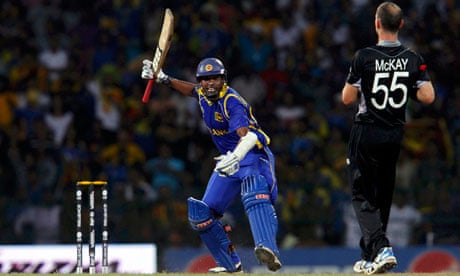For the first time the World Cup final will be contested between two teams from the subcontinent. In the end it was Sri Lanka, looking forward now to their second successive final, who hauled themselves across the line by five wickets against a New Zealand side who fought tooth and claw to the end but in the final analysis failed, in their innings, to give their bowlers enough leeway to defend.
The end when it came was clinical in its brutality. Chasing 218 to win, Sri Lanka, at one point 160 for one and cruising even more easily than they had been against England on the same pitch, contrived, to stunned silence in the Premadasa, to lose four wickets for 25 runs. The tension was there. New Zealand upped their game. In the quarter-final they had induced such tremors in the South African ranks that the opposition simply folded. Could history be repeating itself?
Thilan Samaraweera and Angelo Mathews, the latter with a runner after he was injured during the Black Caps innings, gradually pulled things closer until 14 were needed in four overs. It was the second over of the batting power play, left as late as is possible. The field was in. Tim Southee, massively improved in pace under the tutelage of Alan Donald, tore in. Mathews just swung his bat and deposited the first ball over wide long‑on for six and the third back over the bowler's head to the straight boundary.
Samaraweera thought he had sealed the job at the start of the following over from the left-armer Andy McKay, lacerating the ball through extra cover. But the celebratory fireworks had started prematurely and Aleem Dar had called dead ball. Instead, four balls later Samaraweera steered the same bowler to third man to spark a party in the stands and a lap of honour from the players.
New Zealand once more have shown themselves to be warriors, a country of small population but indomitable spirit, a country of small population but indomitable spirit. It would have taken something remarkable from them to have beaten Sri Lanka but it will rankle, perhaps haunt them, now and in the future that six times they have made the last four of a World Cup without taking it one step further. They should be applauded, though, for making the most of what they have, not criticised for not making even more. One day, perhaps.
Sri Lanka, meanwhile, will fancy their chances against whichever wins the match in Mohali between India and Pakistan, although the manner of their victory in the Premadasa was achieved while exposing a certain vulnerability in the middle and lower order: one more wicket for New Zealand and there would have been some nails bitten.
Until the Kiwis intervened to spoil the party, it had been a match heading inevitably in one direction only. Southee had succeeded where England had not, in forcing a catch from Upal Tharanga (brilliantly taken by an airborne Jesse Ryder, words one might think would never be seen together in context) but not before he had made a brisk 30, from 31 balls, of an opening stand of 40.
All it did, though, was bring together Tillakaratne Dilshan, along with Tharanga a centurion in the 10-wicket defeat of England, and the brilliant Kumar Sangakkara, providing a contrast in styles, technique and approach. Dilshan was more circumspect here, a right-hander who, as with, say, Virender Sehwag, likes to stay legside of the ball in order to free his arms and plunder the offside. The Sri Lanka captain on the other hand, a left-hander, is surgical, slicing and dicing, death for the bowler by a thousand cuts. His driving is precise, spatially aware.
Together the pair added 120 for the second wicket with scarcely an alarm, and, although Daniel Vettori had managed to claw back the run rate, the runs had started to flow again: an easy victory looked certain. Whereupon Dilshan, on 73 (93 balls, 10 fours and a six), drove loosely at Southee and Ryder, at backward point took his second catch.
Vettori then had Mahela Jayawardene lbw, confirmed on review, and when Sangakkara, having made 54 (79 balls with seven fours and a six), upper‑cut McKay to third man, it left two new batsmen at the crease and collapse a possibility. Chamara Silva chopped Southee on to give him a third wicket but Samaraweera and Mathews saw Sri Lanka home.
As with England, New Zealand, having won the toss and knowing the Premadasa history, would have thought there was an initiative to be gained by batting first. Instead the Kiwis were never allowed to gain momentum as Sangakkara switched his bowlers shrewdly. None of the three power players in the Black Caps ranks top four – Brendon McCullum, Ryder and Ross Taylor – were allowed to get away, although Taylor's stand of 77 for the fourth wicket with Scott Styris was the largest of the innings.
Styris was to go on to top score with 57 from 77 balls before he was lbw to Muttiah Muralitharan with what was his final international delivery in Sri Lanka. A combination of Lasith Malinga's malevolent yorkers and the illegible spin of Ashanta Mendis ensured the demise of the innings.
